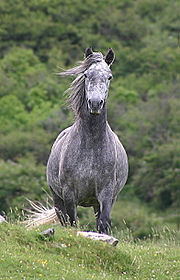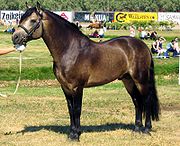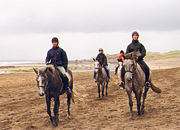
Connemara pony
Encyclopedia
The Connemara pony is a pony breed originating in Ireland
. They are known for their athleticism, versatility and good disposition. The breed makes excellent show ponies.
 The Connemara
The Connemara
region in County Galway
in western Ireland
, where the breed first became recognized as a distinct type, is a very harsh landscape, thus giving rise to a pony breed of hardy, strong individuals. Some believe that the Connemara developed from Scandinavian ponies that the Vikings first brought to Ireland. Another source was likely the Irish Hobby
, a now-extinct breed established prior to the 13th century. Legend, however, says that galleons from the Spanish Armada
ran aground in 1588, and the Andalusian
s on board were set loose. The Spanish horses bred with the native stock, refining the local ponies.
For additional strength and stamina, Arabian
blood was added in the 18th century. They were also crossed with Hackneys
and Thoroughbred
s. Too much crossbreeding began to dilute the pony bloodlines, so the Connemara Pony Breeders’ Society, founded in 1923, worked to preserve the breed type. The stud book
was established in 1926. Today, Connemaras are bred worldwide in Ireland and Britain
, as well as on the European continent, North America
, Australasia
and South Africa
.
Connemaras in North America range from . Recognized colors are gray
, bay, brown (genetically, a darker variant of bay), and dun
, with some roans
, an occasional black
, chestnut
, or palomino
. Pinto
patterns, called piebald
and skewbald
by the Connemara registry, are not acceptable for registration.
Connemara Breed Standards - Set By The CPBS Of Ireland
 If a Connemara pony is to be passed as Grade 1 on inspection, it must meet the following criteria:
If a Connemara pony is to be passed as Grade 1 on inspection, it must meet the following criteria:
If they do not meet this specification then they will be given a Grade 2 or Grade 3 on inspection.
 The Connemara is best known today as a sports pony
The Connemara is best known today as a sports pony
. Ridden by both children and adults, it is considered to be a very versatile pony breed, competitive in show jumping
, dressage
and eventing
, but also with the stamina for endurance riding
. They are also shown in harness
.
Ireland
Ireland is an island to the northwest of continental Europe. It is the third-largest island in Europe and the twentieth-largest island on Earth...
. They are known for their athleticism, versatility and good disposition. The breed makes excellent show ponies.
History

Connemara
Connemara is a district in the west of Ireland consisting of a broad peninsula between Killary Harbour and Kilkieran Bay in the west of County Galway.-Overview:...
region in County Galway
County Galway
County Galway is a county in Ireland. It is located in the West Region and is also part of the province of Connacht. It is named after the city of Galway. Galway County Council is the local authority for the county. There are several strongly Irish-speaking areas in the west of the county...
in western Ireland
Ireland
Ireland is an island to the northwest of continental Europe. It is the third-largest island in Europe and the twentieth-largest island on Earth...
, where the breed first became recognized as a distinct type, is a very harsh landscape, thus giving rise to a pony breed of hardy, strong individuals. Some believe that the Connemara developed from Scandinavian ponies that the Vikings first brought to Ireland. Another source was likely the Irish Hobby
Irish Hobby
The Irish Hobby is an extinct breed of horse native to the British Isles that developed prior to the 13th Century. The breed provided foundation bloodlines for several modern horse breeds, including breeds as diverse as the Connemara pony and the Irish Draught....
, a now-extinct breed established prior to the 13th century. Legend, however, says that galleons from the Spanish Armada
Spanish Armada
This article refers to the Battle of Gravelines, for the modern navy of Spain, see Spanish NavyThe Spanish Armada was the Spanish fleet that sailed against England under the command of the Duke of Medina Sidonia in 1588, with the intention of overthrowing Elizabeth I of England to stop English...
ran aground in 1588, and the Andalusian
Andalusian horse
The Andalusian, also known as the Pure Spanish Horse or PRE , is a horse breed developed in the Iberian Peninsula. Its ancestors have been present on the Iberian Peninsula for thousands of years. The Andalusian has been recognized as an individual breed since the 15th century, and its conformation...
s on board were set loose. The Spanish horses bred with the native stock, refining the local ponies.
For additional strength and stamina, Arabian
Arabian horse
The Arabian or Arab horse is a breed of horse that originated on the Arabian Peninsula. With a distinctive head shape and high tail carriage, the Arabian is one of the most easily recognizable horse breeds in the world. It is also one of the oldest breeds, with archaeological evidence of horses...
blood was added in the 18th century. They were also crossed with Hackneys
Hackney (horse)
The Hackney Horse is a recognized breed of horse that was developed in Great Britain. In recent decades, the breeding of the Hackney has been directed toward producing horses that are ideal for carriage driving. They are an elegant high stepping breed of carriage horse that is popular for showing...
and Thoroughbred
Thoroughbred
The Thoroughbred is a horse breed best known for its use in horse racing. Although the word thoroughbred is sometimes used to refer to any breed of purebred horse, it technically refers only to the Thoroughbred breed...
s. Too much crossbreeding began to dilute the pony bloodlines, so the Connemara Pony Breeders’ Society, founded in 1923, worked to preserve the breed type. The stud book
Breed registry
A breed registry, also known as a stud book or register, in animal husbandry and the hobby of animal fancy, is an official list of animals within a specific breed whose parents are known. Animals are usually registered by their breeders when they are still young...
was established in 1926. Today, Connemaras are bred worldwide in Ireland and Britain
Great Britain
Great Britain or Britain is an island situated to the northwest of Continental Europe. It is the ninth largest island in the world, and the largest European island, as well as the largest of the British Isles...
, as well as on the European continent, North America
North America
North America is a continent wholly within the Northern Hemisphere and almost wholly within the Western Hemisphere. It is also considered a northern subcontinent of the Americas...
, Australasia
Australasia
Australasia is a region of Oceania comprising Australia, New Zealand, the island of New Guinea, and neighbouring islands in the Pacific Ocean. The term was coined by Charles de Brosses in Histoire des navigations aux terres australes...
and South Africa
South Africa
The Republic of South Africa is a country in southern Africa. Located at the southern tip of Africa, it is divided into nine provinces, with of coastline on the Atlantic and Indian oceans...
.
Characteristics
Connemaras are strong and sturdy with a short back and sloped, muscular croup. The hindquarters are powerful. The shoulder is sloped and long. Their legs have short, strong cannons and hard feet and a good stride length. The breed has a fine head with small ears and usually a slightly dished profile set on a well-arched neck. The Connemara is considered hardy and agile, with good jumping ability. The Connemara has a lively but eager and trainable temperament, tends to be long-lived and is described as intelligent. They are hardy and are excellent mounts for children.Connemaras in North America range from . Recognized colors are gray
Gray (horse)
Gray or grey is a coat color of horses characterized by progressive silvering of the colored hairs of the coat. Most gray horses have black skin and dark eyes; unlike many depigmentation genes, gray does not affect skin or eye color Their adult hair coat is white, dappled, or white intermingled...
, bay, brown (genetically, a darker variant of bay), and dun
Dun gene
The dun gene is a dilution gene that affects both red and black pigments in the coat color of a horse. The dun gene has the ability to affect the appearance of all black, bay, or chestnut -based horses to some degree by lightening the base body coat and suppressing the underlying base color to the...
, with some roans
Roan (horse)
Roan is a horse coat color pattern characterized by an even mixture of colored and white hairs on the body, while the head and "points"—lower legs, mane and tail—are more solid-colored. The roan pattern is dominantly-inherited, and is found in many horse breeds...
, an occasional black
Black (horse)
Black is a hair coat color of horses in which the entire hair coat is black. Black is a relatively uncommon coat color, and novices frequently mistake dark chestnuts or bays for black. However, some breeds of horses, such as the Friesian horse, Murgese and Ariegeois are almost exclusively black...
, chestnut
Chestnut (coat)
Chestnut is a hair coat color of horses consisting of a reddish-to-brown coat with a mane and tail the same or lighter in color than the coat. Genetically and visually, chestnut is characterized by the absolute absence of true black hairs...
, or palomino
Palomino
Palomino is a coat color in horses, consisting of a gold coat and white mane and tail. Genetically, the palomino color is created by a single allele of a dilution gene called the cream gene working on a "red" base coat...
. Pinto
Pinto horse
A pinto horse has a coat color that consists of large patches of white and any other color. The distinction between "pinto" and "solid" can be tenuous, as so-called "solid" horses frequently have areas of white hair. Various cultures throughout history appear to have selectively bred for pinto...
patterns, called piebald
Piebald
A piebald or pied animal is one that has a spotting pattern of large unpigmented, usually white, areas of hair, feathers, or scales and normally pigmented patches, generally black. The colour of the animal's skin underneath its coat is also pigmented under the dark patches and unpigmented under...
and skewbald
Skewbald
Skewbald is a color pattern of horses. A skewbald horse has a coat made up of white patches on a non-black base coat, such as chestnut, bay, or any color besides black coat. Skewbald horses which are bay and white are sometimes called tricoloured...
by the Connemara registry, are not acceptable for registration.
Connemara Breed Standards - Set By The CPBS Of Ireland

- Height: .
- Colours: Grey, black, Bay, Brown, Dun with occasional Roan & Chestnut, Palomino and Cremello, called Blue Eyed Cream.
- Type: Compact, well-balanced riding type with good depth and substance and good heart room, standing on short legs, covering a lot of ground.
- Head: well-balanced pony head of medium length with good width between large kindly eyes. Pony ears, well-defined cheekbone jaw relatively deep but not coarse.
- Front: Head well set onto neck. Crest should not be over developed. Neck not set too low. Good length of rein. Well-defined withers, good sloping shoulders.
- Body: Deep, with strong back, some length permissible but should be well-ribbed up and with strong loin.
- Limbs: Good length and strength in forearm, well-defined knees and short cannons, with flat bone *measuring 18cms to 21cms. Elbows should be free. Pasterns of medium length, feet well shaped, of medium size, hard and level.
- Hind Quarters: Strong and Muscular with some length, well-developed second thighs (Gaskin) and strong low-set hocks.
- Movement: free, easy and true, without undue knee action, but active and covering ground.
If they do not meet this specification then they will be given a Grade 2 or Grade 3 on inspection.
Connemara Pony Shows
Connemara Pony shows are held worldwide, however the most famous of all being the Annual Clifden Connemara Pony Show which takes place every August at the Showgrounds, Clifden, Co. Galway. There are 22 in-hand classes and 10 ridden classes. The Connemara Pony Show offers breeders and visitors the chance to witness the very best of Connemara Ponies on display. There is also a dog show, Irish dancing, domestic arts, basket making, and a traditional market day on the streets of Clifden.Uses

Sport horse
Sport horse, or Sporthorse, is a term used to describe a type of horse, rather than any particular breed. The term generally refers to horses bred for the traditional Olympic equestrian sporting events of dressage, eventing, show jumping, and combined driving. The precise definition varies...
. Ridden by both children and adults, it is considered to be a very versatile pony breed, competitive in show jumping
Show jumping
Show jumping, also known as "stadium jumping," "open jumping," or "jumpers," is a member of a family of English riding equestrian events that also includes dressage, eventing, hunters, and equitation. Jumping classes commonly are seen at horse shows throughout the world, including the Olympics...
, dressage
Dressage
Dressage is a competitive equestrian sport, defined by the International Equestrian Federation as "the highest expression of horse training." Competitions are held at all levels from amateur to the World Equestrian Games...
and eventing
Eventing
Eventing is an equestrian event comprising dressage, cross-country, and show jumping. This event has its roots in a comprehensive cavalry test requiring mastery of several types of riding...
, but also with the stamina for endurance riding
Endurance riding
Endurance riding is an equestrian sport based on controlled long-distance races. It is one of the international competitions recognized by the FEI. There are endurance rides worldwide....
. They are also shown in harness
Driving (horse)
Driving, when applied to horses, ponies, mules, or donkeys, is a broad term for hitching equines to a wagon, carriage, cart, sleigh, or other horse-drawn vehicle by means of a harness and working them in this way...
.
See also
- Mountain and moorland poniesMountain and moorlandMountain and moorland or M&M ponies form a group of several breeds of ponies and small horses native to the British Isles. Many of these breeds are derived from semi-feral ponies kept on moorland or heathland, and some of them still live in this way, as well as being kept as fully domesticated...
External links
- http://www.connemaraponybreeders-nicpba.co.uk< Link To The NICPBA - NI Connemara Pony Breeders Association
- Connemara Pony Breeders Society
- American Connemara Pony Society
- British Connemara Pony Society
- Profile
- International Committee of Connemara Pony Societies
- Connemara Pony Breeder Online Pedigree Resourses

